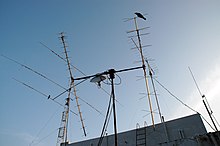
Amateur radio or ham radio is a hobby that is practised by over 16,000 licensed users in India.[1] Licences are granted by the Wireless and Planning and Coordination Wing (WPC), a branch of the Ministry of Communications and Information Technology. In addition, the WPC allocates frequency spectrum in India. The Indian Wireless Telegraphs (Amateur Service) Rules, 1978 lists five licence categories:[2]
To obtain a licence, candidates must pass the Amateur Station Operator's Certificate examination conducted by the WPC.[3] The examination consists of two 50-mark written sections: Radio theory and practice, Regulations; and a practical test consisting of a demonstration of Morse code proficiency in sending and receiving.[4] After passing the examination, the candidate must clear a police interview. After clearance, the WPC grants the licence along with the user-chosen call sign. This procedure can take up to one year.[5] This licence is valid for up to five years.[6]
Each licence category has certain privileges allotted to it, including the allotment of frequencies, output power, and the emission modes. This article lists the various frequencies allotted to various classes, and the corresponding emission modes and input DC power.
- ^ Ramchandran, Ramesh (2005-03-03). "Government to promote amateur radio". The Tribune. Retrieved 2008-07-27.
- ^ Annexure V "The Indian Wireless Telegraphs (Amateur Radio) Rules, 1978" (PDF). Ministry of Communications, Government of India. Controller of Publications, Civil Lines, New Delhi. 1979. p. 34. Archived from the original (PDF) on 2008-10-10. Retrieved 2008-08-03.
- ^ Appendix II "The Indian Wireless Telegraphs (Amateur Radio) Rules, 1978" (PDF). Ministry of Communications, Government of India. Controller of Publications, Civil Lines, New Delhi. 1979. p. 34. Archived from the original (PDF) on 2008-10-10. Retrieved 2008-08-03.
- ^ Annexure III, Appendix I, Section 2.3 "The Indian Wireless Telegraphs (Amateur Radio) Rules, 1978" (PDF). Ministry of Communications, Government of India. Controller of Publications, Civil Lines, New Delhi. 1979. p. 34. Archived from the original (PDF) on 2008-10-10. Retrieved 2008-08-03.
- ^ "Ham operators are a cut above the rest". The Times of India. 2007-05-21. Archived from the original on 2012-10-18. Retrieved 2008-07-25.
- ^ Section 12 "The Indian Wireless Telegraphs (Amateur Radio) Rules, 1978" (PDF). Ministry of Communications, Government of India. Controller of Publications, Civil Lines, New Delhi. 1979. p. 34. Archived from the original (PDF) on 2008-10-10. Retrieved 2008-08-03.